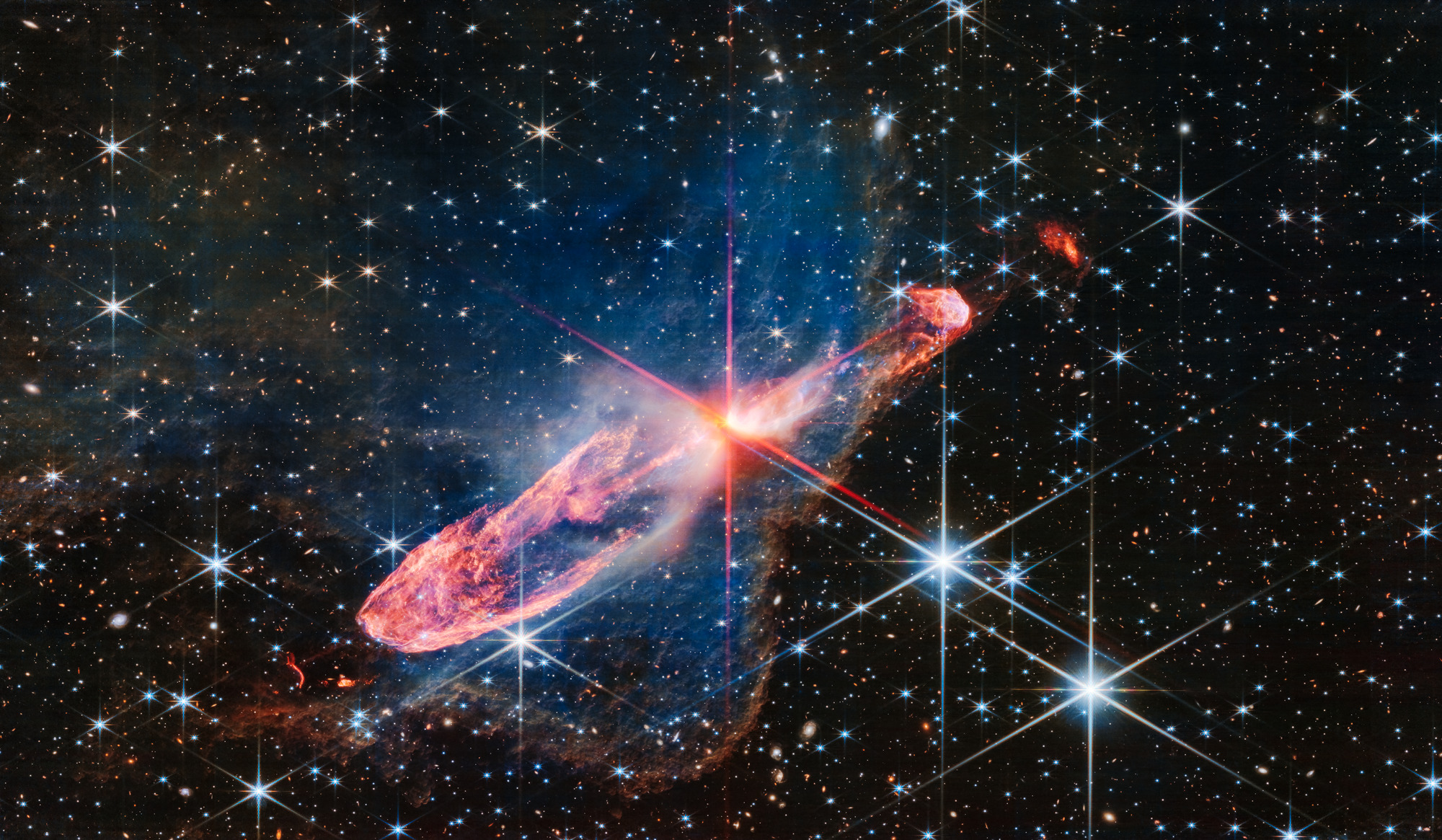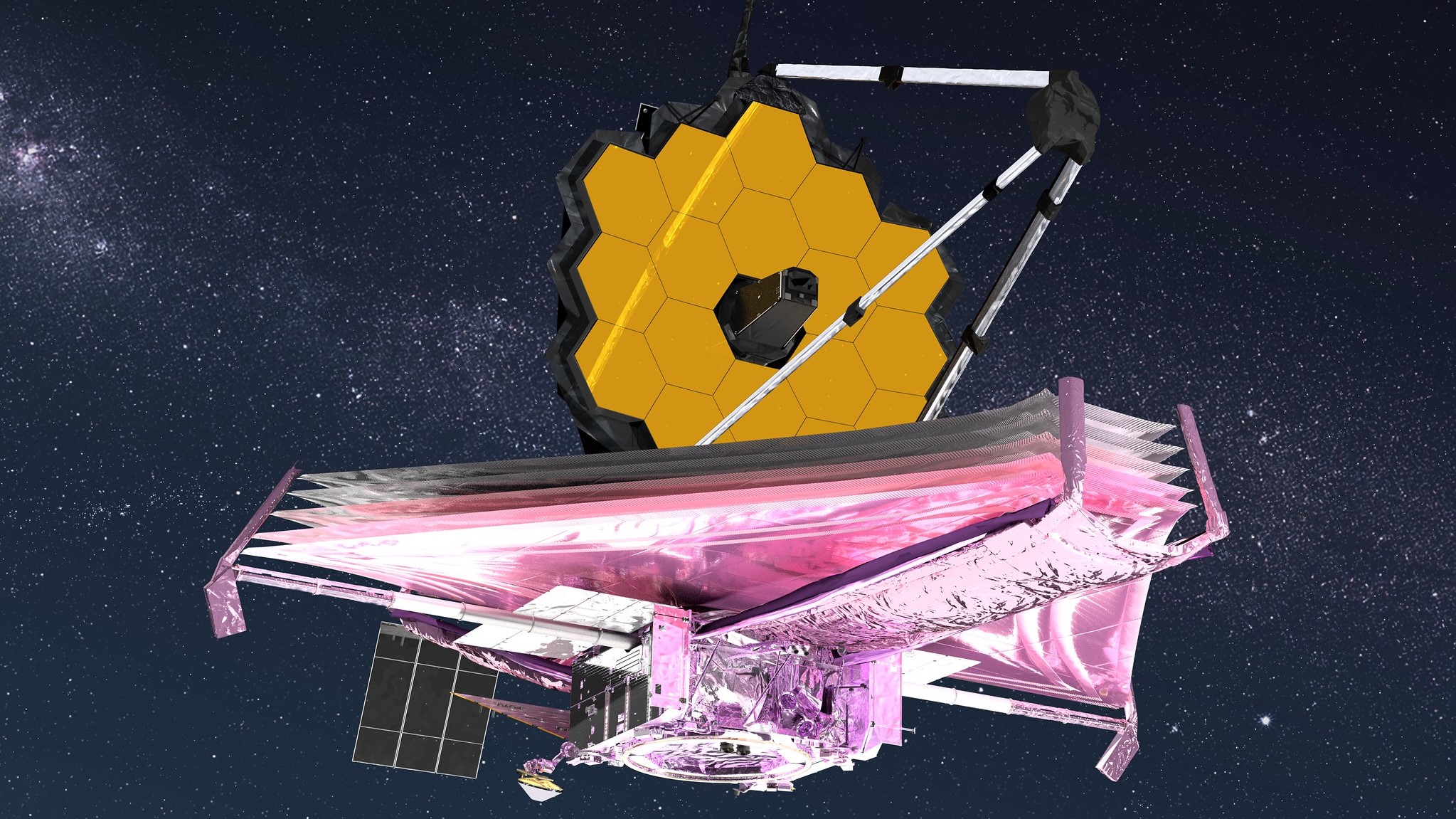
On Wednesday (July 26), scientists announced yet another masterpiece taken by the James Webb Space Telescope. This time around, the machine has presented us with a mesmerizing scene of two actively forming young stars tucked into a pocket of space about 1,470 light-years away.
Produced with the scope's powerful infrared eyes, the image showcases a striking salmon-colored smear at its center. This represents the area where the stars, collectively named Herbig-Haro 46/47, are found. To be clear, because scientists captured everything you see here by harnessing the James Webb Space Telescope's (JWST) infrared sensors, this image would have originally been in black-and-white. Those fiery oranges, pale blues and textured pinks you see were added later to enhance the frame and make it easier to glean scientific information from it.
For instance, you'll see two conical regions of darkness on the glowing splotch’s left and right side. Imagine how the figure is actually in 3D – these structures represent shadows of a gassy, dusty disk floating within the rose-colored blob. This disk tightly surrounds the stellar duo, feeding the baby stars as they grow and mature, a process expected to culminate millions of years from the point the JWST has isolated.
Beyond those structures, NASA calls attention to the main event of the JWST’s latest muse – two huge "lobes" peeking out on either side of the disk. The smaller right lobe falls closer to Earth while the larger left one sits further away.
These lobes are made up of stuff from the dusty disk the stars once ingested, then later spit out into the void of space. Such ejections are considered very important in the act of star formation. You can think of them like a fountain, the agency explains, rapidly switching on and off to form patterns in the pool of our universe. Once these young orbs finish their growth period, they'll ultimately clear the scene of its chaos.
In the background, it's impossible not to notice the dense symphony of stars and galaxies scattered across our universe. Some are old, some are new, some are big and others are small – but each one is equally profound to the realm we call home.

Almost like an artist’s signature, the JWST left its classic eight-pronged diffraction spikes all throughout the image (two of the spikes are tinier than the other six, running horizontally through the center). Photos produced by the Hubble Space Telescope, for instance, exhibit four-spiked stars. It really depends on how many mirrors a machine has – which is why they're called "diffraction spikes" – but when you see those eight, you’ll know it's a JWST image.
Using these features as a guide, there are a few intriguing goodies to zoom in on. If you lower your eyes to the central red diffraction spikes, you’ll catch Herbig-Haro 46/47's most recent ejections. These are shown as strings of blue that move outward until they turn into a light purple halo. Around this diffraction structure are curly, pale blue lines (toward the left) which NASA says are also associated with the stars' ejection patterns. Don’t worry, both are relatively difficult to see as they’re so close to the JWST's spiky penmanship.
Though what you most definitely cannot miss is the ethereal azure curtain shrouding that angry red blob in the middle.
This is another cosmic object known as a nebula, a massive cloud of dust and gas. The JWST is specifically built to filter past such hazes and allow us to peek into whatever lies within – in this case, Herbig-Haro 46/47. In fact, because of that JWST capability, this image marks the most detailed portrait of these stars to date. Thanks to the telescope's high-resolution near-infrared imager and the various exposures it's programmed to tap into, scientists broke past the nebular veil.
Further, the nebula is also why the stars' jets appear to be lit up, according to a press release put out by the JWST team. "As ejected material rams into the nebula on the lower left," the researchers explain, "it takes on wider shapes, because there is more opportunity for the jets to interact with molecules within the nebula."
And thus, the sparkling spectacle we’ve now been blessed with: A picture literally worth a thousand words.
It's so rich with information that even the wealth of image data discussed throughout this article doesn't quite cover the half of what astronomers will be able to learn from it in terms of how stars form.







